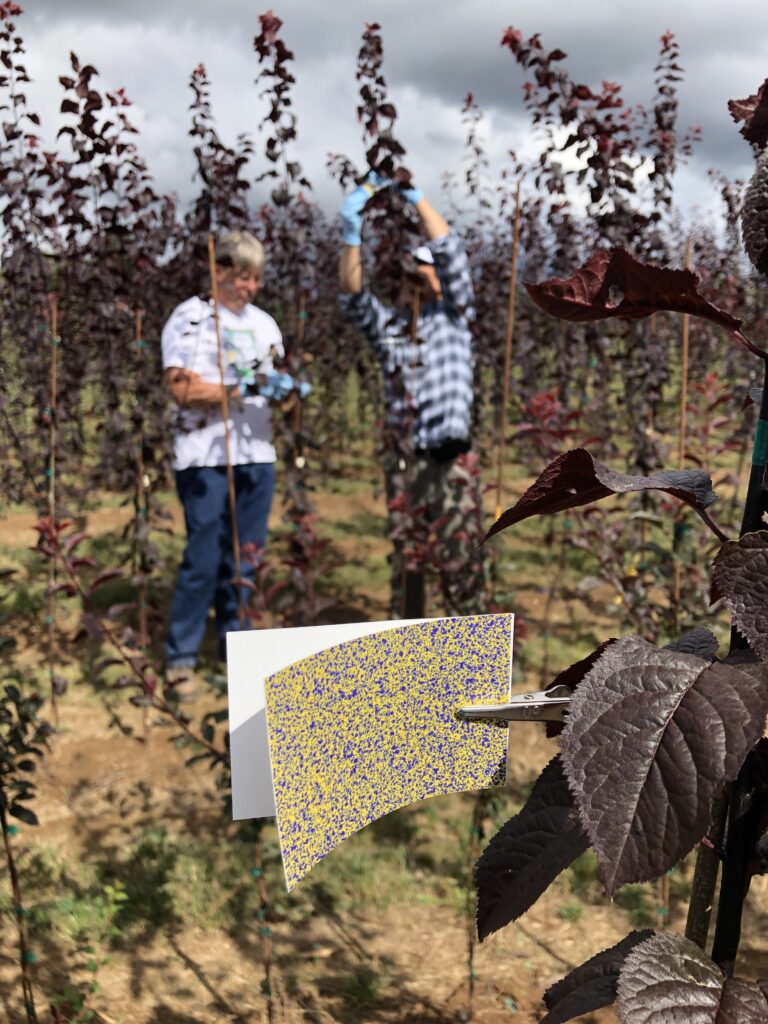Lloyd Nackley
Highlights
- Airblast sprayers should be calibrated throughout the growing season to maximize application efficiency.
- The LiDAR guided Intelligent Sprayer system automatically adjusts to crop canopy sizes.
- Compared to standard Airblast sprayers, the Intelligent Sprayer system can reduce pesticide volumes by more than 50% while achieving adequate coverage, reducing drift by > 33%.
Our research revealed that the majority of directed canopy spraying of specialty crops (defined here as fruits, nuts, and horticultural crops) relies on the radial air blast sprayers. There are many reasons for the continued popularity of air blast sprayers such as customizable sizes, easily available parts for repairs, and robust construction using materials such as stainless steel that provide years of low maintenance use. Although the air blast sprayer continues to be an important and effective tool for the specialty crop industry, its widespread use has not been without issues.
When radial air blast sprayers were first popularized in the 1950s, standard production practices favored hand labor, tree varieties popular at the time were around 6 m tall at maturity, and vines had large dense canopies. Modern plant breeding and horticultural practices, such as pruning and training systems, have revolutionized specialty crop production leading to higher density production systems designed for mechanization. Modern horticulture favors smaller trees (1–4 m tall) that are more productive per unit area than their historical counterparts, and pruning and trellis systems that create more open canopies. Despite the physical transformation of specialty crop production systems, the design of radial air blast sprayers has stayed largely the same. Consequently, unmodified radial air blast sprayers emit air and pesticide volumes that are often much greater than needed in modern high-density, open canopy systems.

Optimizing spray applications is necessary to address increasing pesticide expenses, limited labor availability, stricter regulations, and increased public awareness of pesticide use. For four years the Nackley Lab and Dr. Jay Pscheidt at OSU have been collaborating with USDA-ARS, and the Fulcher group at the University of Tennessee to investigate application of a sensor-guided sprayer in horticultural systems. Sensor-based systems can apply a variable-rate spray that adapts to the changing canopy volume and density thereby reducing waste and off-target deposition compared with standard constant-rate sprayers.

We tested the effect of variable- and constant-rate spray applications and phenological stage on spray volume, coverage, and deposit density in two perennial specialty crop systems: an apple orchard and a grape vineyard. Our research showed that the greatest differences in the volume of pesticide application between constant- and variable-rate sprayer modes occurred early in the season when the canopy was sparse. The standard spray mode discharged a constant volume regardless of the canopy characteristics causing pesticide spray to drift through the open canopies beyond the desired target. Reducing nontarget deposition is critical because aerial drift, ground spray, and runoff can contaminate surface and groundwater and have toxic effects on nontarget species. Unlike the standard spray mode, the Intelligent sprayer mode made real-time adjustments, decreasing the application volume when vegetation was absent, which resulted in a more targeted spray and decreased drift and off-target ground spray. Increasing spray efficiency is critically important because spray losses to the ground and aerial drift by constant-rate, air-assist sprayers can be 40% to 60% of total applied spray in orchards and 10% to 50% the total applied spray volume in vineyards.

If disease and arthropod control are not diminished, reducing the pesticide volume applied on a farm has multifaceted benefits. The most direct benefit, and usually the one that motivates the adoption of variable-rate systems, comes from a reduction in pesticide costs due to lower application volumes. Other research found variable-rate technology can reduce pesticide costs by as much as 67%. Reducing the amount of active ingredient per application also causes a concomitant decrease in environmental impact and worker exposure. Moreover, when the quantity of pesticide required to treat an area is decreased, additional efficiencies are realized from the reduced need to refill, such as lower fuel and labor costs, and improved ability to complete applications in windows of good weather. Additionally, requiring less water as in the case of lower spray volumes is beneficial for orchards and vineyards that have limited access to water.
More info:
Warneke, B.W., J. Pscheidt, and L.L. Nackley. 2021. How to do regular maintenance on air blast sprayers to ensure proper care for specialty crops. https://catalog.extension.oregonstate.edu/em9316
Warneke, B.W., J Pscheidt, R. Rosetta, and L.L. Nackley. 2019. Sensor Sprayers for Specialty Crop Production https://catalog.extension.oregonstate.edu/pnw727
Nackley L.L., B.W. Warneke, L. Fessler, J. Pscheidt, D. Lockwood, W.C. Wright, X Sun, and A. Fulcher. 2021. Variable-rate spray technology optimizes pesticide application by adjusting for seasonal shifts in deciduous perennial crops. HortTechnology 31 https://doi.org/10.21273/HORTTECH04794-21
Warneke,B.W., H. Zhu, J. Pscheidt, and L.L. Nackley. 2020 Canopy spray application technology in specialty crops: a slowly evolving landscape. Pest Manag Sci 77: 2157–2164

